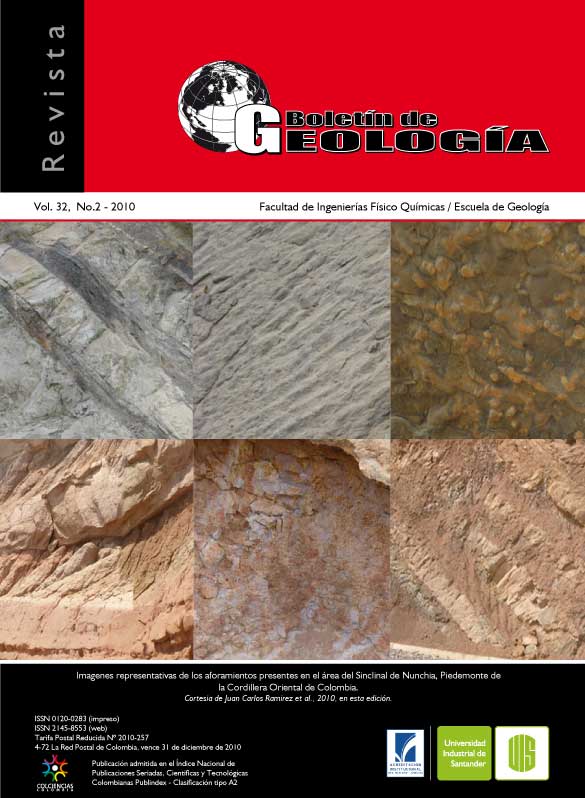CLASIFICACIÓN QUÍMICA Y GEOTERMOMETRÍA DE LAS CLORITAS DE LAS FORMACIONES CRETÁCICAS SANTA ROSA Y LUTITAS DE MACANAL, CINTURÓN ESMERALDÍFERO ORIENTAL, CORDILLERA ORIENTAL, COLOMBIA
How to Cite
Abstract
The study of the chemical composition of chlorites from the Santa Rosa and Lutitas de Macanal Formations in the Eastern Emerald Belt (Eastern Cordillera), are used to estimate the formation temperature of the seminerals and the associated hydrothermal fluids. The chlorites were analyzed using the classification proposed by Hey (1954), Foster (1962), and Bailey (1980); and the formation temperature is calculated from empirical geothermometers from Kranidiotis and MacLean (1987), Cathelineau (1988), Jowett (1991) and Xie et al.(1997). Chlorites in hydrothermally altered rocks associated with emerald mineralization of the Santa Rosa Formation is classified as clinochlore and formed at temperatures of ~354°C, this temperature is consistent with the fluid inclusions in emeralds of the same formation. Chlorites in veins from Lutitas de Macanal Formation are classified as chamosites and formed at lower temperatures between 210-225°C.
Key words: Eastern Cordillera, Chlorites, Eastern Emerald Belt, Geotermometry.
Downloads
References
Cathelineau, M. and Nieva, D. 1985. A chlorite solid solution geothermometer. The Los Azufres (Mexico) geothermal system: Contrib. Mineral Petrol , pp. 235-244.
Cathelineau, M. 1988. Cation site occupancy in chlorites and illites as a function of temperature: Clay Miner, pp. 471-485.
De Caritat, P., Hutcheon, I. and Walshe, J.L. 1993. Chlorite geothermometry: a review. Clays and Clay Minerals, pp. 219-239.
Droop, G.T.R. 1987. A general equation for estimating Fe3+ concentrations in ferromagnesian silicates and oxides from microprobe analyses using stoichiometric criteria. Mineralogical Magazine, 51: 431-435
Foster, M.D. 1962. Interpretation of the composition and a classification of the chlorites. Professional Papers, U.S. Geological Survey, 414-A: 1-33.Hey, M.H. 1954. A new revision of chlorites. Mineralogical Magazine, 30: 277-292
Jowett, E.C. 1991. Fitting iron and magnesium into the hydrothermal chlorite geothermometer. GAC/MAC/SEG Joint Annual Meeting (Toronto, May 27-29, 1991), Program with Abstracts 16, A62.
Klein, E.L., Harris, C., Giret, A. and Moura, C. 2007. The Cipoeiro gold deposit, Gurupi Belt, Brazil: Geology, chlorite geochemistry, and stable isotope study. Journal of South American Earth Sciences, 23: 242-255
Kranidiotis, P. and MacLean, W.H. 1987. Systematics of chlorite alteration at the Phelps Dodge massive sulfide deposit, Matagami, Quebec: Econ. Geol. 82: 1898-1911
Mantilla, L.C, Silva, A., Conde, J., Gaviria, J.A., Gallo, F.H., Torres, D.A., Ortegón, J.A., Silva, E.N., Tarazona, C.A., Castro, B.J., y García, C.A. 2008. Estudio de los procesos de interacción fluido-roca en el Cinturón Esmeraldífero Oriental (Cordillera Oriental, Colombia) y su importancia en la exploración de nuevos yacimientos hidrotermales. INGEOMINAS, Bogota. 496p.
Ortegón, M. 2008. Identificación y caracterización de los pulsos paleohidrotermales en rocas de la Formación Calizas del Guavio (Berriasiano, Cretácico Inferior) y su relación con la mineralización esmeraldífera. Municipio de Gachalá (Cundinamarca). Tesis de Pregrado. Escuela de Geología. Universidad Industrial de Santander (UIS).
